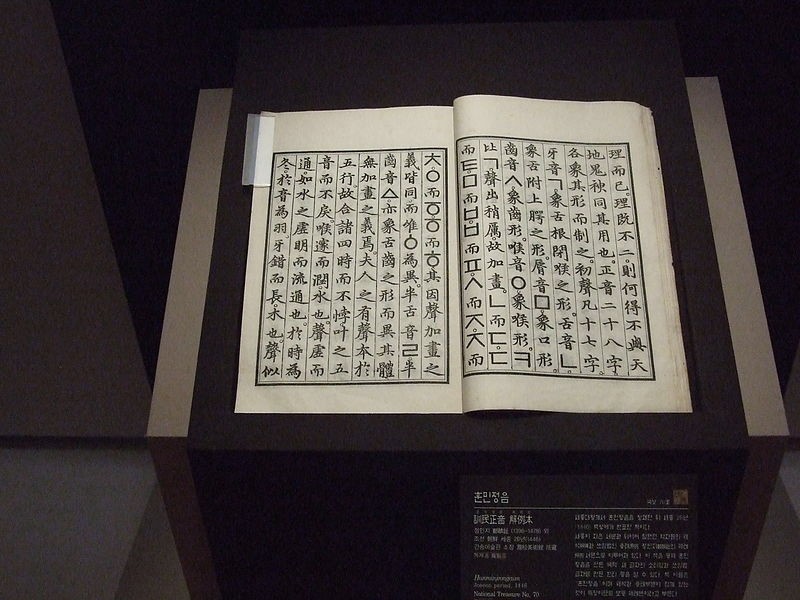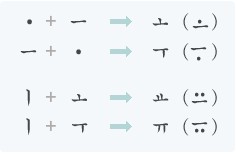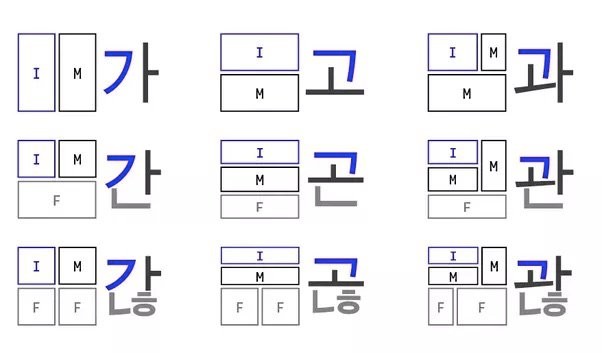
To many, the Republic of Korea is a country renowned for its advanced standard of living and numerous technological innovations. With one of the world’s fastest internet connection speeds, the densest high-speed railway network, and a culture of one-day-delivery not only for packages, but also food and other life essentials, the Republic of Korea’s society is incomparable in its commitment to innovate for the sake of the general public’s well-being and convenience.
One of the most important inventions that embodies this culture of efficiency, accessibility, and consideration for the public good can actually be traced all the way back to the 15th century, during the reign of King Sejong the Great of the Joseon Dynasty, and it remains a major and irreplaceable part of Korean culture, history, and society.
This invention is hangeul, the official writing system of Korea.
For many of the world’s languages, how such writing systems came to be and from where they originated is greatly unknown. For many, only the most general of guesses can be made as to how exactly such commonly used systems came into existence. However, hangeul, being distinguished as one of the world’s youngest writing systems, can be traced back to a single time and person. In fact, hangeul has even been declared by UNESCO as being the only alphabet whose creator and purpose of creation are known.
The creation of hangeul dates back to the year 1443 when King Sejong left a record of his creation of this writing system, detailing the methods he used to create symbols to represent the various sounds of the Korean language. This record is known as <Hunminjeongeum> (훈민정음), which can literally be translated as “the proper sounds for teaching the people.” This manuscript was finished in 1443 by King Sejong and officially released in 1446. The word hunminjeongeum was the script’s original name before it began to be referred to as hangeul.

King Sejong the Great’s [Hunminjeongeum]
Within <Hunminjeongeum>, King Sejong also revealed his motivation for creating such a script. Before the invention of hangeul, people used classical Chinese characters as their official writing system. However, due to the disparity between the Chinese and Korean languages that made the classical Chinese characters difficult to adapt to Korean, as well as the sheer amount of characters that needed to be learned, it was not the easiest nor most practical of systems for people of the Korean peninsula. Especially for those of the lower class who did not have access to the education needed to learn this system, the use of classical Chinese ended up creating a barrier between the educated and uneducated. Seeing this polarization unfold before his eyes, King Sejong took the initiative to create a system that could easily be learned by anyone and began a fierce battle against illiteracy.
As of 2008, the Republic of Korea’s literacy rate for those age fifteen and over was around 98%, a fact in which King Sejong would undoubtedly rejoice upon hearing.
Some milestones in the history of hangeul include the publication of <Yongbieocheonga> (용비어천가, literally “Songs of the Dragons Flying to Heaven”), which was the first script to be published using hangeul. On April 7, 1896, Tongnip Sinmun, (독립신문, “The Independent”) the first newspaper to be printed using hangeul, was published. Additionally, Hangeul Day is a national holiday that occurs every year on October 9 to celebrate the creation of such an exceptional writing system.
Not only is hangeul a very meaningful part of Korean history and culture, but it is also a reflection of the advanced and forward-thinking nature of Korean society and its people. King Sejong created hangeul to precisely reflect the specific phonemes, or individual sounds, of the Korean language, and the system has since received innumerable praises for its scientific approach to documenting spoken language.
Hangeul is an alphabetic system, comparable to the Roman alphabet in that one symbol is used to represent a specific sound. This differs from other writing systems, such as Chinese which is a logographic system. With Chinese characters, one character can represent one morpheme or an entire word, thus rules of pronunciation are often not as clear, though there may be clues within the character. There are also syllabaries, such as the Japanese writing systems of hiragana and katakana, where one character represents one syllable rather than a single phoneme. With such a system, adapting foreign loanwords into the target language is more complicated, as a word’s pronunciation must be adapted to fit these fixed syllables. Even the Roman alphabet has its drawbacks, as the use of silent letters and double consonants, as well as the seemingly infinite number of phonetic changes that occur in certain environments make figuring out the pronunciation of new words rather difficult. For example, consider the vowel “a” in English. If you were to simply see the letter, it would be hard to describe how it is pronounced, since there is more than one way this one letter can be spoken. The words hat, hate, and hall all have the letter “a,” but each “a” is pronounced slightly differently.
In comparison to other systems, the connection between symbol and phoneme using hangeul is very straightforward, to such a degree that someone can know the pronunciation of a completely foreign word almost perfectly by simply reading it. Of course, like any language, there will be some exceptions and rules, but compared to other writing systems, hangeul does an impeccable job at documenting spoken utterances to an exact degree.
Looking at the specific makeup of hangeul, there are a total of 24 letters, consisting of 10 vowels and 14 consonants respectively.
The vowels (ㅏㅑㅓㅕㅗㅛㅜㅠㅡㅣ) were created keeping in the mind the vowel harmony that is a unique characteristic of the Korean language. Simply, the vowels can be divided into yin and yang vowels, with vowels only of the same likeness appearing in certain environments. Therefore, the yin vowels (ㅏ and ㅗ) cannot be preceded or followed by a yang vowel (ㅓ and ㅜ) and vice versa. King Sejong depicted the yin vowels as having extra strokes to the right and up, and the yang vowels with strokes to the left and down. The vowels ㅣ and ㅡ are neutral, and thus are simply a straight line without any extra strokes. It is stated in <Hunminjeongeum> that the shapes of the vowels were created using the Confucian concept of the “three realms,” heaven, earth, and man. Heaven was represented with a dot ( • ) to represent, which was then transformed into the horizontal and vertical strokes seen in the four yin and yang vowels (ㅏㅓㅗㅜ). The concept of earth was drawn as a long horizontal line (ㅡ), and man became a long vertical line (ㅣ). The vowels can be broken down even further into smaller groups that share certain traits, and diving deep into the complexities of just the vowel category reveals how scientific a system hangeul is.


Visual depictions of the Korean vowels and their formation
The shapes of the fourteen consonants (ㄱㄴㄷㄹㅁㅂㅅㅇㅈㅊㅋㅌㅍㅎ) were created based on the placement of speech organs when making each sound. For example, the symbol ㄱ is most closely represented by the Roman alphabet letters “g” or “k”, and is meant to be a representation of how the base of one’s tongue touches the back of the mouth when making this sound. Another example is the letter ㄴ (“n” using the Roman alphabet), which was drawn to depict how one’s tongue curves upwards and presses against the back of the top front teeth when pronouncing this sound.

A visual representation of how the consonants in hangeul are meant to reflect the placement of speech organs when pronouncing each sound
Another unique feature of hangeul is how these symbols are organized to make words and sentences. Thinking about the Roman alphabet, letters are laid out horizontally one after another to make words, with words being separated by spaces to make whole sentences. Hangeul works in a similar fashion, with words being laid out horizontally and separated by blank spaces to make whole sentences. However, hangeul also utilizes the vertical plane to make syllables using the 24 characters, usually organizing characters in clusters of vowel-consonant-vowel and making syllable blocks. This makes for a very neat and compact writing system.

The nine types of syllable blocks that can be seen in Korean writing. These blocks are composed of an initial consonant, one or two medial vowels, and one or two final consonants. These blocks are then strung together to make words and sentences.
Furthermore, hangeul does not have any connection to any other language’s writing system, as it was created specifically for the Korean language. While the occasional use of Chinese characters (hanja) can still be seen in news articles or more professional pieces of writing, hangeul is the predominant system of writing in Korea.
This has only just begun to scratch the surface of the complex workings of hangeul and its design. However, despite the complex scientific and philosophical thoughts that went into creating such a system, hangeul has received the title of being one of the easiest alphabets to learn, many claiming that only two hours are needed to master hangeul. This perfectly reflects King Sejong’s original intent of creating a system that would be easy enough for anyone to learn, even those who were not given equal opportunities for education.
Through its preservation and celebration, hangeul continues to spread King Sejong’s wish of a world united through language, with barriers such as illiteracy no longer able to obstruct people from using their language to their full potential.
Written by : Allison Garbacz
From Illinois, United States. Current 5th-year undergraduate at the University of Wisconsin-Madison, B.A. Candidate for Linguistics, B.A. Candidate for Asian Languages and Cultural Studies, Exchange student at Korea University, Intern at VANK (Voluntary Agency Network of Korea)